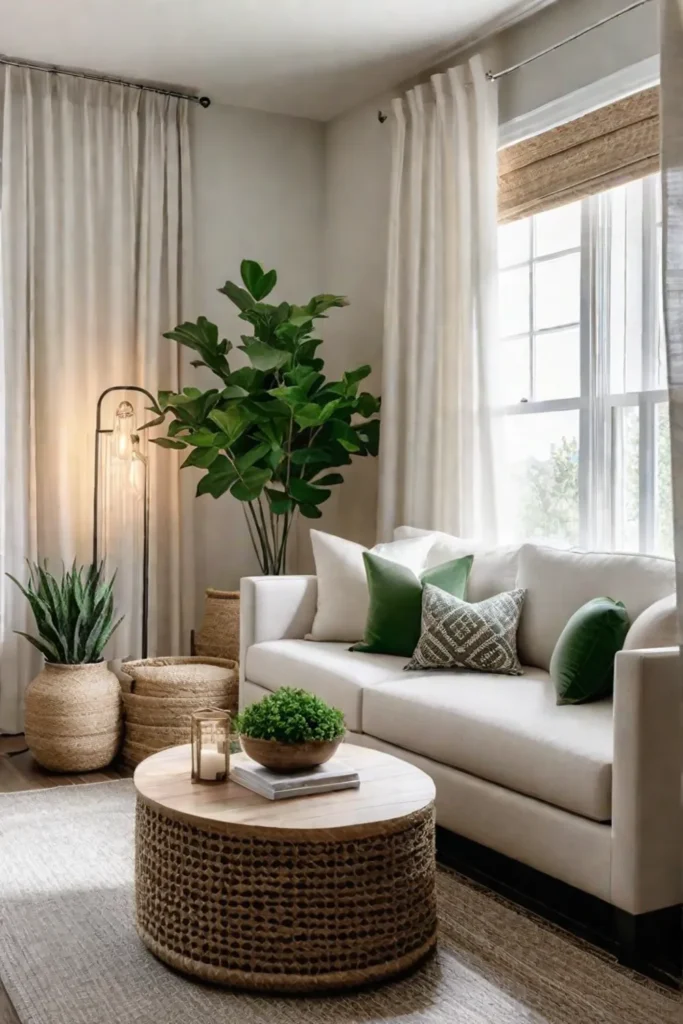Do you ever feel like your living room is more of a stress-inducing battleground than a tranquil oasis? If so, you’re not alone. In today’s fast-paced world, having a space in your home where you can truly unwind and find your zen is more important than ever.
Imagine this: You come home after a long day, kick off your shoes, and sink into a plush, comfortable chair. Soft, natural light filters in through the large windows, casting a warm glow on the room. The neutral color palette and minimalist decor create a calming atmosphere, and the gentle sound of a small water feature provides soothing background noise. It sounds pretty relaxing, doesn’t it?

With a few strategic design choices, you can transform your living room into this serene sanctuary. In this article, we’ll explore the key elements that can help you create a relaxing living room layout and give you the tools to turn your home into your oasis of tranquility.
Comfortable Seating
Let’s start with the foundation of a relaxing living room: comfortable seating. After all, what’s the point of having a zen-like atmosphere if you can’t sink into a cozy chair and truly unwind? When selecting furniture for your living room, prioritize ergonomic design and plush fabrics.
Look for sofas and armchairs with generous cushions and adjustable headrests. These features provide physical support and contribute to an overall sense of relaxation. Arrange your seating in a conversational layout, encouraging you and your guests to engage in leisurely discussions rather than staring straight ahead at a TV.

Studies show that comfortable, well-designed furniture can reduce stress and improve well-being. So, don’t skimp on the comfy factor – your mind and body will thank you.
Maximizing Natural Light
Another crucial element in creating a relaxing living room is natural light. Exposure to sunlight has been shown to improve mood, increase energy levels, and even promote better sleep. So, make the most of any windows or glass doors in your living room to let that natural light pour in.
Position your seating areas near the largest windows to maximize the brightness. Use sheer curtains to filter the light, creating a soft, diffused glow that’s easy on the eyes. You can also incorporate reflective surfaces, like mirrors or polished metal accents, to help bounce the light around the room, making it appear brighter and more spacious.

By maximizing natural light, you’ll set the stage for a calming atmosphere and enjoy the added benefits of improved mood and better sleep. It’s a win-win for your living room and your overall well-being.
Calming Color Palette
The colors you choose for your living room can significantly impact the overall sense of relaxation and tranquility. Opt for soothing neutral tones, like beige, gray, and taupe, which provide a solid foundation for a calming environment. Earthy hues like sage green or muted browns can also create a serene, nature-inspired atmosphere.
Avoid bold, high-contrast colors and patterns that can be visually overwhelming. Instead, stick to a monochromatic color scheme, using shades of the same calming color. This harmonious approach will help reduce visual clutter and promote peace.

Remember, color psychology plays a crucial role in our emotional well-being. Studies have shown that certain colors, like blues and greens, can positively affect our mood and stress levels. By carefully selecting a calming color palette, you’ll be well on your way to creating a living room that truly feels like a personal oasis.
Minimalist Design Approach
Embracing a minimalist design approach can also help foster a sense of serenity and tranquility in your living room. This design philosophy emphasizes simplicity, functionality, and eliminating unnecessary elements, which can contribute to a more relaxed and stress-free environment.
Start by decluttering your living room and removing items that don’t serve a clear purpose. Then, choose furniture and decor pieces with clean lines and a streamlined aesthetic. Prioritize functionality over excessive ornamentation and incorporate only the essential elements needed to create a comfortable and visually appealing space.

The benefits of a minimalist approach are well-documented. Studies have shown that a decluttered, minimalist environment can reduce stress and improve overall well-being. By adopting this design approach, you’ll create a living room free from visual distractions, allowing your mind to unwind and find its zen.
Incorporating Natural Elements
Bringing the outdoors in can also have a calming effect on your living room. Incorporate natural elements like plants, natural materials, and organic textures to create a serene, nature-inspired atmosphere.
Potted plants improve air quality and add a touch of life and vitality to the space. Wooden accents, like a coffee table or bookshelf, can add warmth and texture, while natural fiber rugs or linen curtains can introduce soft, organic elements.

Exposure to nature has been shown to have a soothing effect on the mind and body. Incorporating these natural elements into your living room design will foster a stronger connection to the outdoors, creating a greater sense of calm and relaxation.
Mood Lighting for Relaxation
Lighting is crucial in setting the mood for relaxation in your living room. Opt for soft, indirect lighting that creates a warm, inviting ambiance. Floor lamps, table lamps, and dimmable fixtures can all help you achieve this cozy, calming atmosphere.
Consider using candles or lamps to add a flickering, intimate touch to the room. These light sources’ gentle, soothing glow can help reduce eye strain and promote a sense of tranquility.

Studies have shown that lighting can influence our emotions and help us feel more relaxed. By carefully curating your living room’s lighting, you’ll create a space that encourages you to unwind and find your inner peace.
Soundscaping for Tranquility
Soundscaping is the final piece of the puzzle in creating a relaxing living room layout. Incorporating calming sounds can further enhance the sense of tranquility and serenity in your space.
Consider adding a small water feature like a tabletop fountain to provide gentle, soothing background noise. Alternatively, you can play nature-inspired audio recordings, like the sound of rain or ocean waves, to create a calming, immersive environment.

Sound-absorbing materials, like soft fabrics or rugs, can also help reduce echoes and create a more peaceful acoustic environment. This allows the calming sounds to take center stage, further promoting relaxation and stress reduction.
Exposure to soothing sounds has been shown to impact our overall well-being positively. Incorporating these elements into your living room design will create a space that nourishes the senses and helps you find your zen.
Conclusion
Creating a relaxing living room layout is about striking the perfect balance between comfort, serenity, and functionality. You can transform your living space into a personal oasis of tranquility by focusing on elements like plush seating, natural light, calming colors, minimalist design, natural materials, mood lighting, and soundscaping.

Remember, prioritizing relaxation and well-being in every aspect of your living room design is key to achieving a zen-like atmosphere. So, take a deep breath, let go of the day’s stress, and immerse yourself in the calming sanctuary you’ve created. Your mind and body will thank you.










